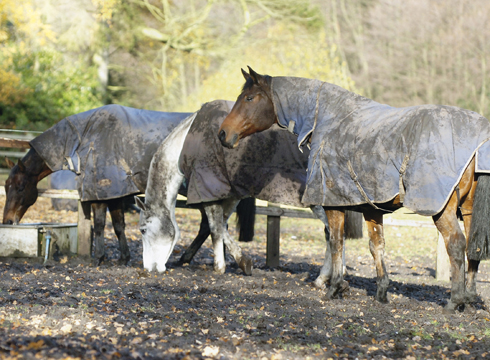Dealing with what this difficult season throws at us can be a challenge for horses and owners. So how can you weather the worst of winter?
Karen Coumbe MRCVS offers advice
There’s rarely an easy winter. Wet and muddy conditions make clean turnout difficult, yet when it is ice-cold the ground is too slippery to be safe.
Whether in or out, our horses are prone to seasonal health issues. Colic in horses is said to be more common in the winter months. Despite this, several studies have failed to prove a definite association between weather conditions, or changes, and cases of colic. With all such studies, it is hard to be sure whether there is bias when recalling events. If it was seriously cold, wet or windy, for instance, there is a tendency to link that to any subsequent questions concerning colic — whether relevant or not.
Similarly, a golden rule of management is that a decent supply of fresh drinking water must be available to prevent colic. Scientific evidence to prove this is scanty, but it still makes sense. Changes in routine, especially in stabling and housing management, have been linked with an increased risk of colic. Obviously, a change in stabling is often closely related to changes in activity, so it is hard to know how reliable this association actually is. But we do recognise that horses are creatures of habit and usually do better with a regular routine.
Tummy trouble
Colic simply means abdominal pain, so includes many different medical and surgical conditions. Certainly, some colic conditions are more common in winter, particularly impaction colic. According to one UK study, this accounted for up to 10% of colic cases seen by vets.
An impaction basically means a blockage and the most common site for this is the pelvic flexure of the colon. This is essentially the last U-bend at the bottom end of the bowel. The change in direction here can all too easily result in a traffic jam, as the gut contents slow down when they turn the corner.
Thankfully, most colon impactions can be cleared without surgical intervention. Repeated treatments of various medications are often required, which may include large volumes of fluids, electrolytes, liquid paraffin or other substances given by stomach tube. Painkillers and sometimes an intravenous fluid drip are needed as well. Long-standing obstructions of the large colon — that is, those that last for more than a couple of days — have an increased tendency to recur. Any straightforward measures that can be taken to minimise colic risks therefore make sense.
Keeping things moving
Horses are less likely to become hot and sweaty in winter and tend to be less thirsty. Others drink less because their water supply is frozen or too cold to be palatable. Offer plenty of fresh drinking water and take the chill off it by adding a little boiling water from a kettle, especially when giving hard feed.
The volume of water consumed is also influenced by the size of the container. Horses drink more from large buckets than small automatic drinkers, where they have to wait for them to refill. Feeding foods with a high water content can help, such as sloppy soaked sugar beet and soaked hay.
A downward spiral can develop if it is too icy to soak hay. A switch to dry hay will increase the need for fresh, clean water — just when it is likely to be unavailable due to the cold. The less a horse drinks, the more solid the gut contents can become — and the more likely an impaction will develop.
Impactions usually occur gradually. There may be early warning signs, such as reduced or dry droppings or reduced water intake. If wintry weather means that horses are kept in more than normal, they may well eat their bedding, which only makes the chance of blockages greater. Inactivity may also slow the movement of food through the digestive tract.
Colic is caused by a number of factors. While we can’t avoid winter altogether, appropriate good management can limit the risk.
Can frosty grass cause colic?
There are anecdotal stories that frosty grass can cause colic, but no certain proof. Common sense suggests it is not ideal — a bit like eating too much ice cream! It is well recognised that frosty grass is associated with an increased incidence of laminitis. This is due to the accumulation of sugars in the grass in the cold weather, which is one good reason to avoid regular turnout on frosty fields.

